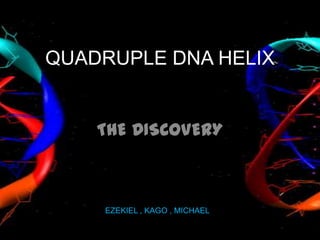
Dna G quadreplex structure discovery
- 1. QUADRUPLE DNA HELIX THE DISCOVERY EZEKIEL , KAGO , MICHAEL
- 2. Road to the discovery of DNA -1969 DNA isolated by Swiss Physician Friedrich Meisches, who, discovered a microscopic substance in the puss of discarded surgical bandages. As it resided in the nuclei of cells, he called it nuclein. -1878 Albsecht Kossel isolates the non-protein component of the protein and later isolates its five primary nucleobases. -1919 Phoebus Leven identifies the base, sugar and phosphate nucleotide unit.
- 3. Road to the discovery of DNA -1937 William Asthry produces the first X-ray diffraction pattern that showed DNA had a regular structure. -1953(phew!!) James D Waston and Francis Crick suggested what is now accepted as the double helix, based on a single X-ray diffraction image (Rosalind Franklin and Raymond Crossling)
- 4. Nucleotides and protein sequences (BY1 stuff, so you obviously know it ) 60 years later……G-quadriplex structure discovered in human cells
- 6. How?? -Intertwine four, rather than two -Use of fluorescent antibody that attaches exclusively to G-quadruplexes(stop them from unraveling into the ordinary DNA) -Enabled the researchers to count how many formed at each stage of cell multiplication. -A marked increase was shown when the fluorescent staining grew more intense during the 's-phase‘ -Exist in cancer cells and normal cells.
- 7. For the Future Cancer treatment Cancers are usually driven by genes called oncogenes that have mutated to increase DNA replication - causing cell proliferation to spiral out of control, and leading to tumour growth. The increased DNA replication rate during oncogenesis leads to an intensity in the quadruplex structures. Therefore if the cancerous cells are exposed to pyridostatin, a molecule that traps quadruple helices wherever they form, it would lead to interruption in synthesis, hence control of cancerous cells.
- 8. For the Future Personalised Medicine. Through the branch of Bioinformatics, the discovery can lead to assimilation of even more specific genome into the intergrated computers for improved diagnosis.
- 9. Professor Shankar Balasubramanian “"I hope our discovery challenges the dogma that we really understand DNA structure because Watson and Crick solved it in 1953”
- 10. THANKS
